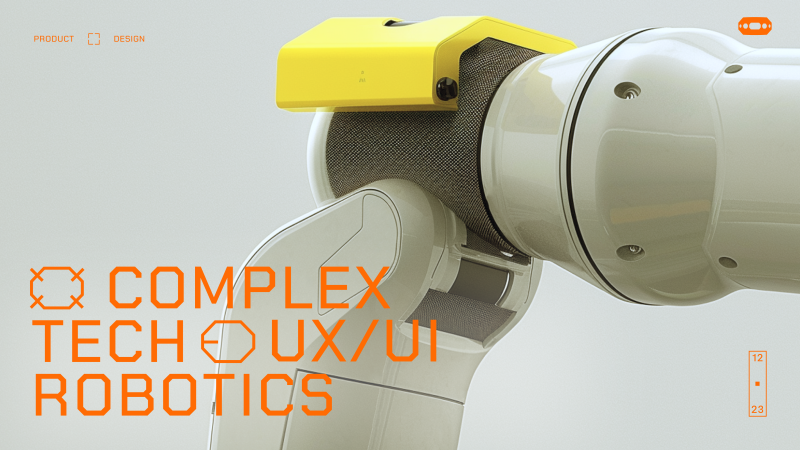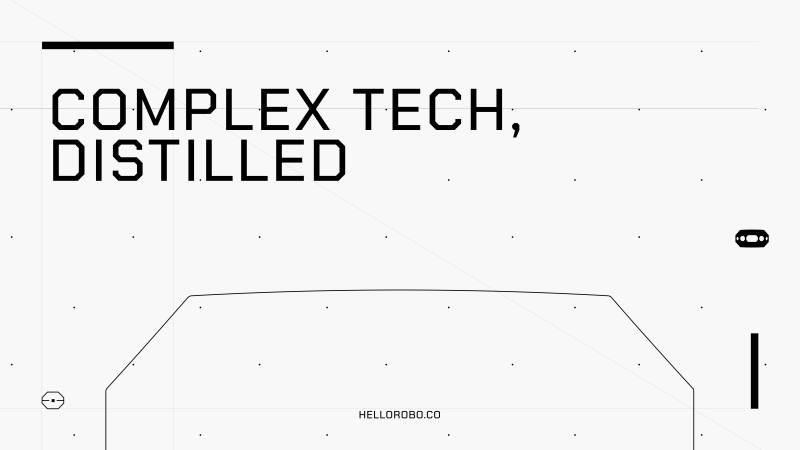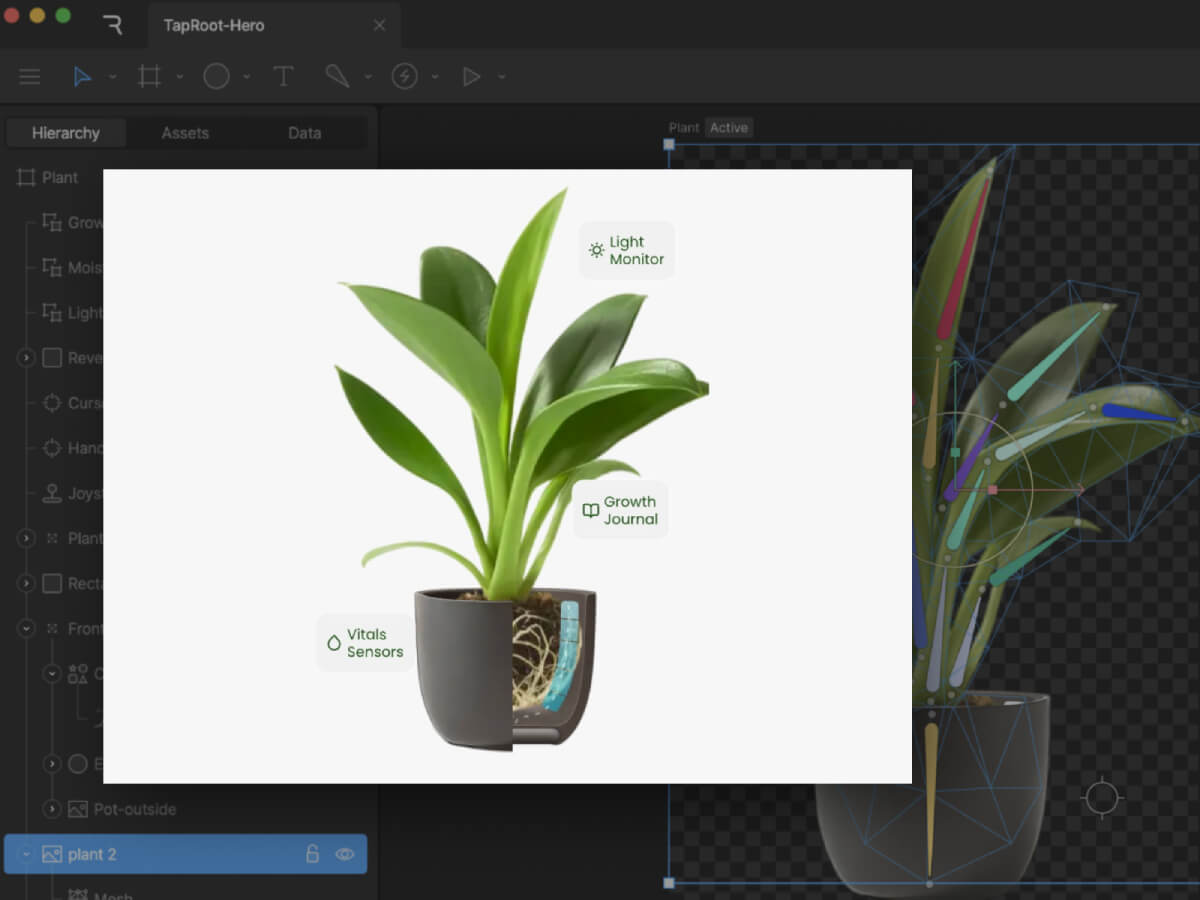Can Python or Ruby Feel First-Class in the Browser?
Source link
برچسب: Can
-
Can Python or Ruby Feel First-Class in the Browser?
-

Hello Robo’s Rebrand: Distilling Complex Tech Into Interfaces Anyone Can Use
Hello Robo is a New York based digital product design agency that turns complex technology into intuitive, usable interfaces. We work with forward-thinking teams to create market-ready digital products that are easy to use and hard to ignore.
Earlier this year, the design team at Hello Robo decided to update our brand and website site to speak the language of our current clients — AI, space, aviation, and robotics — after realizing the old, “startup-y” look sold us short.
The new design and copy showcase our ability to tame complex systems with clear thinking and precise interfaces, signaling to deep-tech teams that we understand their world and can make their products make sense.
We wanted our site to do only 2 things but well:
- Have the design language to appeal to our existing and new target clients
- Most of our work is not allowed to be shared. Our second goal was to let design, motion and interaction give our visitors a sense of what we are great at.
Research
Before we sketching a single screen, our design lead on this project Daria Krauskopf, did what we do before we starting any project at Hello Robo. She decided to talk with our customers. We asked every existing client two questions:
- What do you think we do?
- What’s one thing you think we’re absolutely great at?
The replies were almost word-for-word:
“You do excellent product design—not crazy, unachievable vision design, and not MVPs either. You’re absolutely great at taking complex, technical systems and turning them into beautiful interfaces that our users actually love to use.”
That became the foundation for how we approached the new site.
Design & Art Direction
We love robots—and robotics inspires everything we do. For the new site, we moved away from soft colors and rounded corners and leaned into a more hi-tech visual language: dark backgrounds, thin lines, sharper shapes. Daria wanted the design to feel more precise, more engineered—something that would resonate with the kind of clients we work with in aviation, robotics, and defense. Every visual choice was about clarity, control, and intention.
A few boards from Hello Robo new brand, reimagined by our design Hanna Shpak




Animation and Interaction
All of our interface work is rooted in interaction and motion—because real-world products aren’t static. They always change and respond to users input and actions. We wanted the site to reflect that. Not with flashy effects or distracting transitions, but with just enough subtle animation to guide, respond, and feel alive. Everything moves with purpose—quiet, responsive, and smooth.
Case Studies
We didn’t want our case studies to be just a scroll of pretty images. Each one is built as a story—showing not just what we made, but how it worked and why it mattered. We walk through key features, the thinking behind UX decisions, and the problems we solved for each client. It’s less about showing off visuals, and more about showing how we think.
Final words
In the end, we got what we set out to build: a clearer visual and verbal language that reflects who we are and who we work with. The site feels more aligned with the complexity and ambition of our clients—and with the way we approach design: thoughtful, precise, and grounded in real product work. It’s not trying to impress with noise. It’s built to resonate with the kind of teams who care about clarity, systems, and getting things right.
Credits
Web designer: Daria Krauskopf
Brand design: Hanna Shpak
UX design: Vlad Duhnov
Webflow development: Miron Umantsev
Design director: Shakir Dzheyranov
-

From Static to Dynamic: 3 Micro-Animations Every Web Developer Can Master with Rive

Interactive web animations have become essential for modern websites, but choosing the right implementation approach can be challenging. CSS, Video and JavaScript are the familiar methods and each certainly has its place in a developer’s toolkit. When you need your site to have unique custom interactions (while remaining light and performant, of course), that’s where Rive shines.
Rive animations, whether vector or raster, look crisp at any size, are lightweight (often smaller than equivalent Lottie files), and can respond to user interactions and real-time data through a straightforward JavaScript API.
This tutorial will walk you through Rive’s workflow and implementation process using three practical examples. We’ll build them step-by-step using a fictional smart plant care company called “TapRoot” as our case study, so you can see exactly how Rive fits into a real development process and decide if it’s right for your next project.
There are countless ways to use Rive, but we’ll focus on these three patterns:
- Animated Hero Images create an immediate emotional connection and brand personality
- Interactive CTAs increase conversion rates by providing clear, satisfying feedback
- Flexible Layouts combine elements into an experience that works at any size
Each pattern builds on the previous one, teaching you progressively more sophisticated Rive techniques while solving real-world UX challenges.
Pattern 1: The Living Hero Image
The Static Starting Point
A static hero section for TapRoot could feature a photo of their smart plant pot with overlay text. It show’s the product, but we can do better.

Creating the Rive Animation
Let’s create an animated version that transforms this simple scene into a revealing experience that literally shows what makes TapRoot “smarter than it looks.” The animation features:
- Gently swaying leaves: Constant, subtle motion brings a sense of life to the page.
- Interior-reveal effect: Hovering over the pot reveals the hidden root system and embedded sensors
- Product Feature Callouts: Key features are highlighted with interactive callouts

Although Rive is vector-based, you can also import JPG, PNG, and PSD files. With an embedded image, a mesh can be constructed and a series of bones can be bound to it. Animating the bones gives the subtle motion of the leaves moving. We’ll loop it at a slow speed so the motion is noticeable, but not distracting.
Adding Interactivity
Next we’ll add a hover animation that reveals the inside of the pot. By clipping the image of the front of the pot to a rectangle, we can resize the shape to reveal the layers underneath. Using a joystick allows us to have an animation follow the cursor when it’s in within the hit area of the pot and snap back to normal when the cursor leaves the area.

Feature Callouts
With a nested artboard, it is easy to build a single layout to create multiple versions of an element. In this case, a feature callout has an updated icon, title, and short description for three separate features.

The Result
What was once a simple product photo is now an interactive revelation of TapRoot’s hidden intelligence. The animation embodies the brand message—”smarter than it looks”—by literally revealing the sophisticated technology beneath a beautifully minimal exterior.
Pattern 2: The Conversion-Boosting Interactive CTA
Beyond the Basic Button
Most CTAs are afterthoughts—a colored rectangle with text. But your CTA is often the most important element on your page. Let’s make it irresistible.
The Static Starting Point
<button class="cta-button">Get yours today</button>.cta-button { background: #4CAF50; color: white; padding: 16px 32px; border: none; border-radius: 8px; font-size: 18px; cursor: pointer; transition: background-color 0.3s; } .cta-button:hover { background: #45a049; }Looks like this:
Get’s the job done, but we can do better.
The Rive Animation Design
Our smart CTA tells a story in three states:
- Idle State: Clean, minimal button with an occasional “shine” animation
- Hover State: Fingerprint icon begins to follow the cursor
- Click State: An animated “tap” of the button
Pattern 3: Flexible Layout
Next we can combine the elements into a responsive animated layout that works on any device size. Rive’s layout features familiar row and column arrangements and lets you determine how your animated elements fit within areas as they resize.
Check this out on the Rive Marketplace to dive into the file or remix it: https://rive.app/community/files/21264-39951-taproot-layout/
Beyond These Three Patterns
Once you’re comfortable with hero images, interactive CTAs, and flexible layouts, you can apply the same Rive principles to:
- Loading states that tell stories while users wait
- Form validation that guides users with gentle visual feedback
- Data visualizations that reveal insights through motion
- Onboarding flows that teach through interaction
- Error states that maintain user confidence through friendly animation
Your Next Steps
- Start Simple: Choose one existing static element on your site
- Design with Purpose: Every animation should solve a real user problem
- Test and Iterate: Measure performance and user satisfaction
- Explore Further: Check out the Rive Documentation and Community for inspiration
Conclusion
The web is becoming more interactive and alive. By understanding how to implement Rive animations—from X-ray reveals to root network interactions—you’re adding tools that create experiences users remember and share.
The difference between a good website and a great one often comes down to these subtle details: the satisfying feedback of a button click, the smooth transition between themes, the curiosity sparked by hidden technology. These micro-interactions connect with users on an emotional level while providing genuine functional value.
-
Automating Your DevOps: Writing Scripts that Save Time and Headaches | by Ulas Can Cengiz
Or, how scripting revolutionized my workflow
Photo by Stephen Dawson on Unsplash Imagine a time when factories were full of life, with gears turning and machines working together. It was a big change, like what’s happening today with computers. In the world of creating and managing software, we’re moving from doing things by hand to letting computers do the work. I’ve seen this change happen, and I can tell you, writing little programs, or “scripts,” is what’s making this change possible.
Just like factories changed how things were made, these little programs are changing the way we handle software. They’re like a magic trick that turns long, boring tasks into quick and easy ones. In this article, I’m going to show you how these little programs fit into the bigger picture, how they make things better and faster, and the headaches they can take away.
We’re going to go on a trip together. I’ll show you how things used to be done, talk about the different kinds of little programs and tools we use now, and share some of the tricks I’ve learned. I’ll tell you stories about times when these little programs really made a difference, give you tips, and show you some examples. So, buckle up, and let’s jump into this world where making and managing software is not just a job, but something really special.
-

How Data Analytics Can Help You Grow Your Business
In today’s fast-paced and competitive business landscape, companies must leverage data analytics to better understand their customers, improve products and services, and make informed decisions that can help their business grow. With the right tools and insightful analytics, businesses can identify new opportunities, spot trends, and gain a competitive advantage. In this article, we will explore four ways data analytics can help you grow your business. Keep reading to learn more.
Boosting Customer Engagement and Loyalty

One of the primary benefits of using data analytics in your business is the ability to better understand your customers. By collecting and analyzing customer data, you can gain insights into their preferences, needs, and behaviors. This information can then be used to create targeted marketing campaigns and personalized experiences that are tailored to their specific interests. As a result, customers will feel more engaged with your brand and are more likely to remain loyal, resulting in higher customer retention rates and increased revenue.
Additionally, by analyzing customer feedback, businesses can determine what aspects of their products or services require improvement. This can lead to increased customer satisfaction and an even stronger brand reputation. Having access to some of the best data analytics programs can greatly enhance your understanding of your target audience.
Furthermore, data analytics allows businesses to identify and reach out to potential customers, leading to a more effective acquisition process. By utilizing various channels, techniques, and types of data, businesses can identify potential customers who are most likely to convert, allowing them to maximize their marketing efforts and investments.
Improving Operational Efficiency
Data analytics can also be invaluable in improving operational efficiency within a business. By collecting and analyzing data from internal processes, businesses can pinpoint areas of inefficiency, identify bottlenecks, and determine areas that require optimization. This can lead to significant cost savings and better resource allocation, ultimately resulting in improved profitability.
Data analytics can also be applied to supply chain management, helping businesses optimize their inventory levels, reduce waste, and manage their relationships with suppliers more effectively. This can result in a more streamlined supply chain, leading to improved customer satisfaction and increased revenue.
Businesses that are involved in transportation or logistics, such as those utilizing Esso Diesel for fuel, can also employ data analytics for optimizing routes and vehicle performance. By analyzing data on fuel consumption, traffic patterns, and driver behavior, businesses can implement more cost-effective and efficient transportation strategies, leading to significant savings and a better environmental footprint.
Supporting Informed Decision-Making
Data analytics is a key tool in helping business leaders make more informed and data-driven decisions. Rather than relying on intuition or gut feelings, businesses can use data to analyze past performance, project future trends, and identify patterns to support their decision-making process. This results in better strategic planning and more effective decision-making, enabling businesses to grow and stay ahead of their competition.
For example, data analytics can be used to identify revenue-generating products or services, allowing businesses to focus their resources on these areas. This can help to consolidate their position within the market and drive growth through targeted investments and expansion.
Innovating and Developing New Products

Lastly, data analytics can support innovation by helping businesses to identify new product development opportunities. By understanding customer needs, preferences, and pain points, businesses can develop products and services that meet the demands of their existing customers, but also attract new ones.
Furthermore, data analytics can be used to identify emerging trends or unmet needs within the market. By leveraging this information, businesses can position themselves as leaders and innovators within their industry, setting them apart from their competitors and driving growth.
Data analytics is a powerful tool that can drive growth and improvements across various aspects of a business, from enhancing customer engagement and loyalty to optimizing internal processes, supporting informed decision-making, and fostering innovation. By harnessing the power of data analytics, businesses can set themselves on a path to sustained growth and success.
-
How Can Advanced Gadgets Help Your Business Succeed?
In today’s competitive business environment, leveraging advanced technology is not just advantageous but often essential for staying ahead. From improving operational efficiency to enhancing customer experiences, advanced gadgets play a crucial role in driving business success. Despite the challenges businesses face, such as the statistic that up to 70% of all business partnerships fail, integrating advanced gadgets can mitigate risks and propel growth.
Enhancing Operational Efficiency
One of the primary benefits of advanced gadgets in business is their ability to streamline operations and boost productivity. Whether it’s through automation tools, smart devices, or advanced software solutions, technology empowers businesses to automate repetitive tasks, optimize workflows, and allocate resources more effectively. By reducing manual errors and accelerating processes, businesses can achieve greater efficiency and operational excellence.
Ensuring Workplace Safety
The safety and security of employees and assets are paramount concerns for any business. According to the National Fire Protection Association, an average of 3,340 fires occur in offices every year, highlighting the importance of robust safety measures. Advanced gadgets such as smart fire detection systems, CCTV cameras with AI-powered analytics, and automated emergency response systems can significantly enhance workplace safety. These technologies not only detect potential hazards early but also enable swift responses, mitigating risks and minimizing damage.
Navigating Regulatory Compliance
Navigating regulatory requirements and tax obligations is another critical aspect of business operations. For example, in New Jersey, the State Treasury imposes a 6.625% Sales Tax on sales of most tangible personal property, specified digital products, and certain services unless exempt under state law. Advanced gadgets equipped with financial management software can automate tax calculations, ensure compliance with regulatory standards, and facilitate accurate reporting. By reducing the burden of manual compliance tasks, businesses can avoid penalties and optimize financial processes.
Empowering Customer Engagement
Customer engagement and satisfaction are fundamental drivers of business growth. Advanced gadgets such as customer relationship management (CRM) systems, personalized marketing automation tools, and AI-powered chatbots enable businesses to deliver tailored experiences and responsive customer service. These technologies analyze customer data in real-time, anticipate needs, and personalize interactions, fostering long-term customer loyalty and driving revenue growth.
Harnessing Data for Strategic Insights
In today’s data-driven economy, insights derived from data analytics can provide businesses with a competitive edge. Advanced gadgets equipped with analytics tools collect, analyze, and visualize data from various sources, offering valuable insights into market trends, customer behavior, and operational performance. By making informed decisions based on data-driven insights, businesses can identify opportunities, mitigate risks, and optimize strategies for sustainable growth.
Improving Decision-Making with Real-Time Analytics
Advanced gadgets are invaluable in empowering businesses with real-time data analytics capabilities. These tools enable organizations to gather and analyze data swiftly, providing deep insights into market dynamics, consumer preferences, and operational efficiencies. By harnessing these insights, businesses can make informed decisions promptly, adapt strategies proactively, and capitalize on emerging opportunities. Real-time analytics not only enhances strategic planning but also optimizes resource allocation, driving sustained growth and competitiveness in today’s fast-paced business landscape.
Conclusion
In conclusion, integrating advanced gadgets into business operations can significantly enhance efficiency, safety, compliance, customer engagement, and strategic decision-making. Despite the challenges highlighted by statistics showing high business partnership failure rates and the prevalence of office fires, advanced technology offers solutions to mitigate risks and drive success. By leveraging automation, enhancing safety measures, ensuring regulatory compliance, empowering customer engagement, and harnessing data-driven insights, businesses can navigate challenges more effectively and capitalize on opportunities in a rapidly evolving marketplace.
As technology continues to evolve, businesses that embrace advanced gadgets not only position themselves for current success but also future-proof their operations against emerging challenges. By investing in the right technology solutions and adapting them to meet specific business needs, organizations can innovate, grow, and thrive in an increasingly competitive landscape. Embracing the transformative potential of advanced gadgets is not merely advantageous but imperative for businesses striving to achieve sustainable success and leadership in their respective industries.
